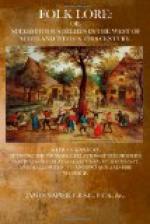Now, let us compare with this the practices current at Hogmanay (31st December), and New Year’s Day, about the commencement of this century. In doing so, I will pass over without notice many superstitious observances which, though curious and interesting, belong rather to the general fund of superstitious belief than to the special festival at New Year, and confine myself to those which were peculiar to the time. In my grandfather’s house, between sixty and seventy years ago, on the 31st December (Hogmanay), all household work was stopped, rock emptied, yarn reeled and hanked, and wheel and reel put into an outhouse. The house itself was white-washed and cleaned. A block of wood or large piece of coal was put on the fire about ten p.m., so that it would be burning briskly before the household retired to bed. The last thing done by those who possessed a cow or horse was to visit the byre or stable, and I have been told that it was the practice with some, twenty years before my recollection, to say the Lord’s Prayer during this visit. After rising on New Year’s Day, the first care of those who possessed cattle was to visit the byre or stable, and with their own hands give the animals a feed. Burns followed this habit, and refers to it in one of his poems:—
“A gude New Year I wish thee,
Maggy,
Hae, there’s a rip to
thy auld baggie.”




